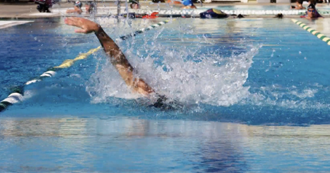Courtesy of Gary Hall Sr., 10-time World Record Holder, 3-time Olympian, 1976 Olympic Games US Flagbearer and The Race Club co-founder.
The Three Styles of Freestyle: Hip-Driven, Shoulder-Driven and Hybrid
Shoulder Driven Freestyle Technique
The stroke rate for shoulder-driven freestyle ranges from around 85 strokes per minute to nearly 150 strokes per minute. In the 50 meter sprint, for example, a swimmer that uses a stroke rate of 120 has a one second cycle time from hand entry to the same hand entry on the next stroke. There is a gray area between 75 and 85 strokes per minute, where hip-driven freestyle transitions into a shoulder-driven technique. Swimming is not a black and white sport.
Other than a faster stroke rate, shoulder-driven freestyle is defined by an early downward force of the hand after entry and an earlier hand release at the end of the pull. The swimmer relies on higher stroke rates (RPM) to gain speed rather than maximizing the propulsion from each pull.
The other key technique of shoulder-driven freestyle is the big and aggressive shoulder rotation that occurs with each stroke. The hips rotate also, but much less than the shoulders do. To get the powerful shoulder rotation, the arms need to recover more vertically over the water. In sprinting, the arms often recover with a straighter arm motion, rather than a bent motion. We refer to that arm recovery technique as high-octane recovery.
Virtually all elite sprinters use shoulder driven freestyle technique. Most elite women use shoulder-driven freestyle technique for all events from the 50 to the 1500 meter event. In the men’s freestyle events, we see both shoulder-driven and hybrid techniques being used in middle-distance events (100 and 200 meters). In the longer events (400 meters and up), we see all three freestyle techniques being used.

Olympic freestyle sprinter, Brad Tandy, uses a straight arm, (high-octane) shoulder driven freestyle technique.
In summary, when it comes to sprinting freestyle, use a shoulder-driven freestyle technique with a stroke rate of 120 or higher and with a higher-octane recovery. If you are going to use the shoulder-driven freestyle for the 100 meter freestyle, the stroke rate should be kept around 100 or more. In the events of 200 meters or longer, use a stroke rate with shoulder-driven freestyle at 86 or higher. In order to compete at these stroke rates, a swimmer must also train at these stroke rates.
Yours in swimming,
Gary Sr.
Like The Race Club on Facebook
Follow The Race Club on Instagram
Follow The Race Club on Twitter
Connect to The Race Club / Gary Hall Sr. on Linkedin
THE RACE CLUB
Because Life is Worth Swimming, our mission is to promote swimming through sport, lifelong enjoyment, and good health benefits. Our objective is for each member of and each participant in The Race Club to improve his or her swimming performances, health, and self-esteem through our educational programs, services and creativity. We strive to help each member of The Race Club overcome challenges and reach his or her individual life goals.
The Race Club provides facilities, coaching, training, technical instruction, video, fitness and health programs for swimmers of all ages and abilities. Race Club swim camps are designed and tailored to satisfy each swimmer’s needs, whether one is trying to reach the Olympic Games or simply improve one’s fitness. Our programs are suitable for beginner swimmers, pleasure swimmers, fitness swimmers, USA swimming or YMCA swimmers, or triathletes; anyone who wants to improve swimming skills. All of our Race Club members share an enjoyment of being in the water and use swimming to stimulate a more active mind and body.


